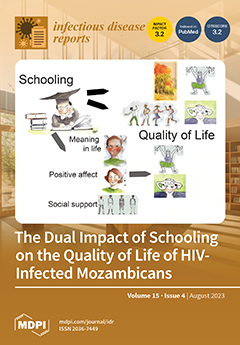Drug-resistant tuberculosis (DR-TB) is still a major public health concern in South Africa. Mutations in
M. tuberculosis can cause varying levels of phenotypic resistance to anti-TB medications. There have been no prior studies on gene mutations and the genotyping of DR-TB in the
[...] Read more.
Drug-resistant tuberculosis (DR-TB) is still a major public health concern in South Africa. Mutations in
M. tuberculosis can cause varying levels of phenotypic resistance to anti-TB medications. There have been no prior studies on gene mutations and the genotyping of DR-TB in the rural Eastern Cape Province; hence, we aimed to identify DR-TB mutations, genetic diversity, and allocated lineages among patients in this area. Using Xpert
® MTB/RIF, we assessed the rifampin resistance of sputum samples collected from 1157 patients suspected of having tuberculosis. GenoType MTBDR plus VER 2.0 was used for the detection of mutations causing resistance to anti-TB medications. The next step was to spoligotype 441 isolates. The most prevalent rifampin resistance-conferring mutations were in
rpoB codon S531L in INH-resistant strains; the
katG gene at codon S315TB and the
inhA gene at codon C-15TB had the most mutations; 54.5% and 24.7%, respectively. In addition, 24.6% of strains showed mutations in both the
rpoB and
inhA genes, while 69.9% of strains showed mutations in both the
katG and
rpoB genes. Heteroresistance was seen in 17.9% of all cases in the study. According to spoligotyping analysis, Beijing families predominated. Investigation of the evolutionary lineages of
M. tuberculosis isolates can be carried out using the information provided by the study’s diversity of mutations. In locations wherein these mutations have been discovered, decision-making regarding the standardization of treatment regimens or individualized treatment may be aided by the detection frequency of
rpoB,
katG, and
inhA mutations in various study areas.
Full article






